The
EuroPreArt Database System
Andrea
Arcà - Footsteps of Man

The EuroPreArt project has two mains goals:
prehistoric art documentation and its diffusion. Its EuroPreArt
Database System is the key to both aims. Development can be
summarised in four steps: preparation, data collection, intermediate
treatment and sharing data online . In all steps, specific
archaeological and rock-art expertise merged with that of
information technology (mainly data management, html scripting
and Web design).
- Preparation. The
first step of the EuroPreArt project partners was to outline
a database system, in the process, reviewing concepts
disclosed in documents and meetings for more than two
decades. Important sources include the files of CIARAO
(International Commission of Western Alps Rock Art 1990)
and WARA (World Archive of Rock Art), and a system called
RAD (Rupestrian Archaeology Database). In this first phase,
the project structured a "rocks file" with forms to catalogue
each engraved or painted prehistoric rock surface, decorated
menhir or portable art object. Future work will add a
"sites file" and a "figures file", in order to achieve
an integrated documentation path under a general sites-surfaces-figures
structure. The main themes of this first file are related
to environment, description and chronology of the "art",
and analysis of the state of conservation, adding also
as much information as possible about bibliography and
intervention.
- Data collection.
Establishing a EuroPreArt data entry form was the second
step. It runs under Microsoft Access (chosen for its availability)
and has five tables (main, bibliography, keywords, links,
institutions), seven tabs, 72 fields (numeric, text, logical
and memo). The first two tabs data relate to location,
geography (position, orientation, land usage) and proximity
to any important natural or human landscape element. The
third tab, probably the core tab, displays information
about detailed chronology and detailed description of
the "art" (style, overlappings, comparisons, correlation,
technique, figures). The next tab is entirely for the
bibliography. There is a pragmatic limit of 8 specific
titles for each record but it is possible to insert as
many titles as needed in the general bibliography. Bibliographical
data are managed by the online site to generate three
different lists: specific (surface or object related),
general (country related) and total (the entire EuroPreArt
bibliography). The fifth tab is for conservation: status
(public, private), detailed description of the state of
conservation and of the risks of damage, information about
restoration, recording, site management and education.
The sixth tab is for images: photos and tracings are not
stored in the Microsoft Access file, only entries referring
to separate picture-files kept outside the database. The
last tab is for additional notes and information about
the institution and compiler of the record. Have a look
at each one of the pages below and download the Access
file. Members of the database development team are M.S.
Abreu (UTAD, Vila Real), A. Arcà and A. Fossati
(Footsteps of Man Society), A Velho and G. Velho
(IPT Tomar). A. Arcà (Footsteps of Man, Italy)
structured and designed the dynamic Web site.
- Intermediate treatment.
Beside this common structure, EuroPreArt partners worked
on their separate geographic sets of records. Therefore,
the third step consisted in manipulating various Microsoft
Access tables, which were exported and merged into two
main databases: "prehistoric art" and "bibliography".
Exportation takes care of memo fields and the ANSI character
set required by different European languages. The final
format chosen was xBase (FoxPro or dBaseIV dbf), which
is greatly customisable in terms of data management and
html implementation and free from Microsoft ASP or server
constraints. Shareware and freeware software, readily
available online, greatly helped in this intermediate
phase.
- Online data-sharing.
The best choice to achieve the second main goal of the
EuroPreArt project, its diffusion is the world-wide-web.
The technical solution for this final step is a dynamic
Web site, where a template-based structure dynamically
generates pages in response to data retrieval requests.
The final form, which obviously contains the same data
of the original data entry forms, shows texts and pictures
with a properly formatted graphic interface, readable
and printable with almost any web browser. BASERUNNER
(www.baserunner.com), a shareware resource, provides the
database capability of the EuroPreArt Web site (europreart.net).
It runs under Linux or Windows servers. No ASP, SQL or
ODBC commands are needed: commands, functions, expressions,
variables and memo files are the usual ones of an xBase
environment.
The EuroPreArt Database System presents its results in the
europreart.net site: seven European countries are involved
(Denmark, France, Ireland, Italy, Portugal, Spain and Sweden),
with more than 750 records of prehistoric art, 2000 images
and 2500 reference titles. We hope that the project will be
able to offer significant data to both general and specialist
audiences. We hope also that future improvements will add
new sets of records, widening the covered area and deepening
the documentation capabilities, so achieving a complete sites-surfaces-figures
structure. |
Page A - Location
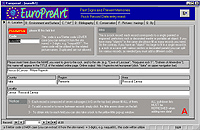
Page B - Environment
and Surface
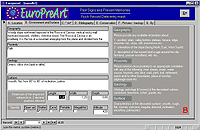
Page C - "Art"
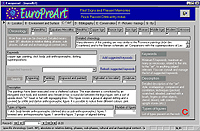
Page D - Bibliography
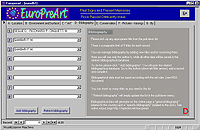
Page E - Conservation
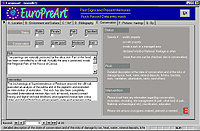
Page F - Pictures
- tracings
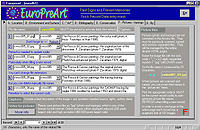
Page G - By
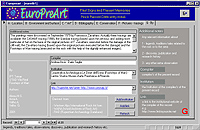
Biblio
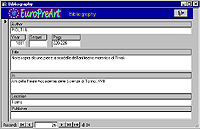
|